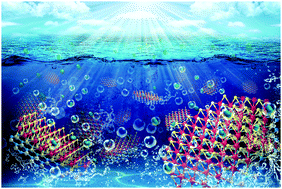MoS2/ZnO van der Waals heterostructure as a high-efficiency water splitting photocatalyst: a first-principles study
Abstract
Previous investigations [H. L. Zhuang and R. G. Hennig, J. Phys. Chem. C, 2013, 117, 20440–20445; J. Kang, S. Tongay, J. Zhou, J. Li and J. Wu, Appl. Phys. Lett., 2013, 102, 012111] demonstrated that molybdenum disulfide (MoS2) is a potential photocatalyst for water splitting. However, the photogenerated electron–hole pairs in MoS2 remain in the same spatial regions, resulting in a high rate of recombination. Using first-principles calculations, we designed a MoS2-based heterostructure by stacking MoS2 on two-dimensional zinc oxide (ZnO) and investigated its structural, electronic, and optical properties. The interaction at the MoS2/ZnO interface was found to be dominated by van der Waals (vdW) forces. The energy levels of both water oxidation and reduction lie within the bandgap of the MoS2/ZnO vdW heterostructure, which guarantee their occurrence for water splitting. Moreover, a type-II band alignment and a large built-in electric field are formed at the MoS2/ZnO interface, which ensure the enhanced separation of the photogenerated electron–hole pairs. In addition, strong optical absorption in the visible region was also found in the MoS2/ZnO vdW heterostructure, indicating that it has potential for application in photovoltaic and photocatalytic devices.



 Please wait while we load your content...
Please wait while we load your content...